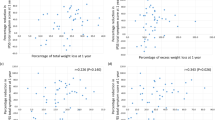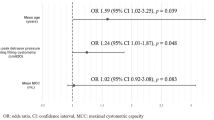Abstract
In the developed and developing countries, the overall prevalence of central obesity in the elderly men is growing. In addition, the progressive aging of male population increased the possibilities of coexisting morbidities associated with obesity such as lower urinary tract symptoms (LUTS) due to benign prostatic enlargement (BPE) or to prostate cancer (PCa) needing primary treatment, including radical prostatectomy (RP), which can further adversely affect the quality of life. Simple and radical prostatectomy are the most common surgical procedures in urologic unit all over the world for BPE and PCa, respectively. After both interventions, patients can present bothering storage LUTS that can worsen all the other clinical outcomes. Preset study will review the role of central obesity as a risk factor for storage LUTS or urinary incontinence, after prostatic surgery for BPE or PCa.

Similar content being viewed by others
References
Papers of particular interest, published recently, have been highlighted as: • Of importance •• Of major importance
Eckel RH, Alberti KG, Grundy SM, Zimmet PZ. The metabolic syndrome. Lancet. 2010;375(9710):181–3.
Finucane MM, Stevens GA, Cowan MJ, et al. Global Burden of Metabolic Risk Factors of Chronic Diseases Collaborating Group (Body Mass Index): national, regional, and global trends in body-mass index since 1980: systematic analysis of health examination surveys and epidemiological studies with 960 country-years and 9.1 million participants. Lancet. 2011;377(9765):557–67.
Giovannucci E, Rimm EB, Chute CG, et al. Obesity and benign prostatic hyperplasia. Am J Epidemiol. 1994;140:989.
Lee RK, Chung D, Chughtai B, Te AE, Kaplan SA. Central obesity as measured by waist circumference is predictive of severity of lower urinary tract symptoms. BJU Int. 2012;110(4):540–5.
Vignozzi L, Gacci M, Cellai I, Santi R, Corona G, Morelli A, et al. Fat boosts, while androgen receptor activation counteracts, BPH-associated prostate inflammation. Prostate. 2013;73(8):789–800.
Vignozzi L, Morelli A, Sarchielli E, et al. Testosterone protects from metabolic syndrome-associated prostate inflammation: an experimental study in rabbit. J Endocrinol. 2012;212(1):71–84.
Morelli A, Comeglio P, Filippi S, et al. Testosterone and farnesoid X receptor agonist INT-747 counteract high fat diet-induced bladder alterations in a rabbit model of metabolic syndrome. J Steroid Biochem Mol Biol. 2012;132(1–2):80–92.
Comeglio P, Morelli A, Cellai I, Vignozzi L, Sarchielli E, Filippi S, et al. Opposite effects of tamoxifen on metabolic syndrome-induced bladder and prostate alterations: a role for GPR30/GPER? Prostate. 2014;74(1):10–28.
Corona G, Vignozzi L, Sforza A, Mannucci E, Maggi M. Obesity and late-onset hypogonadism. Mol Cell Endocrinol. 2015;418(Pt 2):120–33.
Vignozzi L, Gacci M, Maggi M. Lower urinary tract symptoms, benign prostatic hyperplasia and metabolic syndrome. Nat Rev Urol. 2016;13(2):108–19.
Hammarsten J, Högstedt B, Holthuis N, Mellström D. Components of the metabolic syndrome-risk factors for the development of benign prostatic hyperplasia. Prostate Cancer Prostatic Dis. 1998;1:157–62.
Dahle SE, Chokkalingam AP, Gao YT, Deng J, Stanczyk FZ, Hsing AW. Body size and serum levels of insulin and leptin in relation to the risk of benign prostatichyperplasia. J Urol. 2002;168:599–604.
Ozden C, Ozdal OL, Urgancioglu G, Koyuncu H, Gokkaya S, Memis A. The correlation between metabolic syndrome and prostatic growth in patients with benign prostatic hyperplasia. Eur Urol. 2007;51:199–203.
Park YW, Kim SB, Kwon H, et al. The relationship between lower urinary tract symptoms/benign prostatic hyperplasia and the number of components of metabolic syndrome. Urology. 2013;82(3):674–9.
Parsons JK, Messer K, White M, et al. Obesity increases and physical activity decreases lower urinary tract symptom risk in older men: the Osteoporotic Fractures in Men study. Eur Urol. 2011;60:1173–80.
Penson DF, Munro HM, Signorello LB, et al. Obesity, physical activity and lower urinary tract symptoms: results from the Southern Community Cohort Study. J Urol. 2011;186:2316–22.
Kristal AR, Arnold KB, Schenk JM, et al. Race/ethnicity, obesity, health related behaviors and the risk of symptomatic benign prostatic hyperplasia: results from the prostate cancer prevention trial. J Urol. 2007;177:1395–400.
Wang S, Mao Q, Lin Y, et al. Body mass index and risk of BPH: a meta-analysis. Prostate Cancer Prostatic Dis. 2012;15:265–72.
Barbosa JA, Muracca E, Nakano E, Paranhos M, Natalino R, Cordeiro P, et al. Risk factors for male lower urinary tract symptoms: the role of metabolic syndrome and androgenetic alopecia in a Latin American population. Urology. 2013;82(1):182–8.
Pashootan P, Ploussard G, Cocaul A, de Gouvello A, Desgrandchamps F. Association between metabolic syndrome and severity of lower urinary tract symptoms (LUTS): an observational study in a 4666 European men cohort. BJU Int. 2015;116:124–30.
Gacci M, Corona G, Vignozzi L, et al. Metabolic syndrome and benign prostatic enlargement: a systematic review and meta-analysis. BJU Int. 2015;115(1):24–31.
Mondul AM, Giovannucci E, Platz EAA. Prospective study of obesity, and the incidence and progression of lower urinary tract symptoms. J Urol. 2014;191:715–21.
Groutz A, Gordon D, Schachter P, Amir H, Shimonov M. Effects of bariatric surgery on male lower urinary tract symptoms and sexual function. Neurourol Urodyn. 2016.
Maserejian NN, Chen S, Chiu GR, et al. Treatment status and progression or regression of lower urinary tract symptoms in a general adult population sample. J Urol. 2014;191(1):107–13.
Cyrus A, Kabir A, Goodarzi D, Talaei A, Moradi A, Rafiee M, et al. Impact of metabolic syndrome on response to medical treatment of benign prostatic hyperplasia. Korean J Urol. 2014;55(12):814–20.
Gravas S, Bach T, Bachmann A, Drake M, Gacci M, Gratzke C, et al. Guidelines Associates: Karavitakis M, Malde S, Sakkalis V, Umbach R: EAU Guidelines 2016: Treatment of non neurogenic Male LUTS; see: https://uroweb.org/guideline/treatment-of-non-neurogenic-male-luts/ EAU guidelines on non-neurogenic male LUTS treatment. State of the art.
Sener NC, Zengin K, Ozturk U, Bas O, Ercil H, Ekici M, et al. The impact of metabolic syndrome on the outcomes of transurethral resection of the prostate. J Endourol. 2015;29(3):340–3. The authors investigate the effect of metabolic syndrome and its components on the outcomes of TURP.
McVary KT, Peterson A, Donatucci CF, Baygani S, Henneges C, Clouth J, et al. Use of structural equation modeling to demonstrate the differential impact of storage and voiding LUTS on symptom bother and quality-of-life during treatment for LUTS associated with BPH: an integrated analysis of 4 randomized, double-blind placebo-controlled trials. J Urol. 2016. In press. A Structural equation modeling was employed to evaluate physiologic inter-relationships measured by the IPSS storage subscore questions vs. IPSS voiding subscore questions, and to measure the magnitude of their effects on bother via BPH impact index and QoL.
Gacci M, Sebastianelli A, Salvi M, De Nunzio C, Tubaro A, Vignozzi L, et al. Central obesity is predictive of persistent storage lower urinary tract symptoms (LUTS) after surgery for benign prostatic enlargement: results of a multicentre prospective study. BJU Int. 2015;116(2):271–7. The authors evaluate the impact of components of metabolic syndrome on urinary outcomes after surgery for severe LUTS.
Novara G, Ficarra V, Rosen RC, Artibani W, Costello A, Eastham JA, et al. Systematic review and meta-analysis of perioperative outcomes and complications after robot-assisted radical prostatectomy. Eur Urol. 2012;62(3):431–52.
Gacci M, Baldi E, Tamburrino L, Detti B, Livi L, De Nunzio C, et al. Quality of life and sexual health in the aging of PCa survivors. Int J Endocrinol. 2014;2014:470–592.
Gacci M, Simonato A, Masieri L, Gore JL, Lanciotti M, Mantella A, et al. Urinary and sexual outcomes in long-term (5+ years) prostate cancer disease free survivors after radical prostatectomy. Health Qual Life Outcomes. 2009;7:94.
Gacci M, Carini M, Simonato A, Imbimbo C, Gontero P, Briganti A, et al. Factors predicting continence recovery 1 month after radical prostatectomy: results of a multicenter survey. Int J Urol. 2011;18(10):700–8.
Choi EY, Jeong J, Kang DI, Johnson K, Ercolani M, Jang T, et al. Impact of robot-assisted radical prostatectomy on health-related quality of life in patients with lower urinary tract symptoms. Int J Urol. 2011;18(4):297–303.
van Roermund JG, van Basten JP, Kiemeney LA, Karthaus HF, Witjes JA. Impact of obesity on surgical outcomes following open radical prostatectomy. Urol Int. 2009;82(3):256–61.
Campeggi A, Xylinas E, Ploussard G, Ouzaid I, Fabre A, Allory Y, et al. Impact of body mass index on perioperative morbidity, oncological, and functional outcomes after extraperitoneal laparoscopic radical prostatectomy. Urology. 2012;80(3):576–84.
Wiltz AL, Shikanov S, Eggener SE, Katz MH, Thong AE, Steinberg GD, et al. Robotic radical prostatectomy in overweight and obese patients: oncological and validated-functional outcomes. Urology. 2009;73(2):316–22.
Kim JH, Ha Y-S, Jeong SJ, Lee D-H, Kim W-J, Kim IY. Impact of robot-assisted radical prostatectomy on lower urinary tract symptoms and predictive factors for symptom changes: a longitudinal study. Urology. 2013;81:787–93.
Xu T, Wang X, Xia L, Zhang X, Qin L, Zhong S, et al. Robot-assisted prostatectomy in obese patients: how influential is obesity on operative outcomes? J Endourol. 2015;29(2):198–208.
Gacci M, Sebastianelli A, Salvi M, De Nunzio C, Schiavina R, Simonato A, et al. Role of abdominal obesity for functional outcomes and complications in men treated with radical prostatectomy for prostate cancer: results of the Multicenter Italian Report on Radical Prostatectomy (MIRROR) study. Scand J Urol. 2014;48(2):138–45. The authors evaluate the impact of abdominal obesity on preoperative features, complications and functional outcomes of men treated with radical prostatectomy for prostate cancer.
Simonin O, Savoie PH, Serment G, Bladou F, Karsenty G. Urinary incontinence following open prostatectomy or laparoscopy for local prostate cancer. A review of relevant literature. Prog Urol. 2010;20(4):239–50.
Noblett KL, Jensen JK, Ostergard DR. The relationship of body mass index to intra-abdominal pressure as measured by multichannel cystometry. Int Urogynecol J Pelvic Floor Dysfunct. 1997;8(6):323–6.
Author information
Authors and Affiliations
Corresponding author
Ethics declarations
Conflict of Interest
Mauro Gacci, Arcangelo Sebastianelli, Matteo Salvi, Cosimo De Nunzio, Andrea Tubaro, Stavros Gravas, Ignacio Moncada, Sergio Serni, Mario Maggi, and Linda Vignozzi each declare no potential conflicts of interest.
Human and Animal Rights and Informed Consent
This article does not contain any studies with human or animal subjects performed by any of the authors.
Additional information
This article is part of the Topical Collection on Benign Prostatic Hyperplasia
Rights and permissions
About this article
Cite this article
Gacci, M., Sebastianelli, A., Salvi, M. et al. The Impact of Central Obesity on Storage Luts and Urinary Incontinence After Prostatic Surgery. Curr Urol Rep 17, 61 (2016). https://doi.org/10.1007/s11934-016-0620-4
Published:
DOI: https://doi.org/10.1007/s11934-016-0620-4




